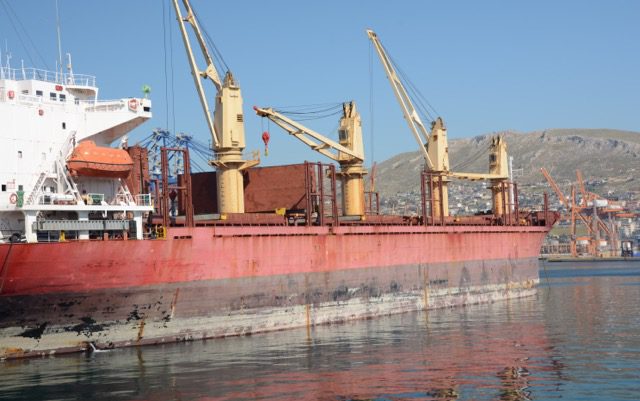Visiting with clients in shipping during recent trips to Europe, one can positively see the angst and anguish emanating from the state of the dry bulk market.
Most segments of dry bulk vessels for several months now barely earn enough to cover their operating expenses and this has been worrying to shipowners active in the sector. Back-of-the-envelope estimates, average spot earnings for capesize vessels in the six months have been below $6,000 pd while a market estimate of such vessel’s daily OpEx is approximately $7,500 pd, implying that the owner had to dip into their cash reserves to keep the vessel afloat. If there was a mortgage on the vessel – most likely – then the cash bleeding is more serious, to the tune of $10,000 + $20,000 pd depending on the specifics of the project.
This is just for one vessel, thus for an owner with ten, twenty or more vessels, one doesn’t really want to think about numbers. And there are many owners in the dry bulk market, in Greece, Germany, Singapore, Hong Kong, Japan, and China.
The state of the dry bulk market has caught many people in the industry by surprise, from owners to charterers to lenders, and, yes, some of the ‘smart money’ in the industry, too.
Certain weakness was expected due to the orderbook placed and the wave of dry bulk vessels starting delivering in 2015, but that the BDI would make all time lows and keep bouncing around such number for several months now was less clearly projected. Certain of the weakness in the shipping market is attributable to the Chinese slow down with lower industrial production, lower both imports and exports, prior over-production of steel plate, etc with no use in mind, and more broadly, the world economies are not exactly breezing effortlessly to the races. Point in case, while the Fed had indicated since last year their concern for possibility of high inflation, recent news have been indicating that the economy may not be as strong as thought to be.
The concern about the state of the dry bulk market is understood. When a great deal of shipowners are bleeding cash, generally it cannot be good for the market, the bankers, the investors, the service providers – that is clearly obvious.
The concern about the state of the dry-bulk market is also understood since it cropped up when everybody was thinking that the worst of the bad times (2008 – 2010) were definitely behind us and many companies revving up for IPOs and other exit strategies. The concern about the state of the dry bulk market is also understood given the persistence and the severity of the downturn and the range along an all-time bottom for almost a year now; at least, the crash of 2008 came ferociously fast with the market (BDI) dropping like a rock, but there was a sort of ‘V-shape’ type of recovery within a year (BDI went from 11,793 points on May 28th, 2008 to 663 on December 5th of that year, to above 4,000 points by June of 2009; the BDI has been, on average, below the 1,000 mark since January 2014 and the last three months very close to thirty-year lows.
All in all, the ferociousness of the present down-cycle was not seen coming to a great extent, which has made the pain so unbearable to hold.
So far, so bad.
While the pain persists, there is some consolation, actually an interesting combination of talk and solace and reminiscing at a funeral and praying and calling on the market’s ‘animal spirits’ that there may be a silver lining to the crisis, as demolition of dry bulk vessels has recently accelerated.
While from the beginning of 2008 until the end of 2010 only twenty million deadweight of dry bulk vessels were scrapped, year-to-date close to eleven million deadweight of dry bulk vessels were scrapped. Selling a vessel for scrap is a hard decision a shipowner has to make since a vessel is sold for scrap, she’s gone for good, the market be damned; and normally this is a decision that is delayed as much as possible, in the hope that tomorrow’s market may be better.
In the previous down-cycle, shipowners held on to their vessels for a number of reasons such as they had thicker cash reserves coming freshly out of a super-cycle, because they were not scared enough, because the banks didn’t push hard enough, or because the market quickly bounced back. The bottom line is that in the previous down-cycle, the withdrawal rate from the world dry bulk was not fast and strong enough to have a material impact on the world fleet.
Well, maybe this time around the market is scary enough to force owners to beach older and non-commercially viable vessels and have them permanently leave the market.
Another point of hope and discussion at present is that the pace of placing new orders for dry bulk vessels has trickled down to a stop. Year-to-date, 1.2 million deadweight of newbuildings have been placed for dry bulk vessels versus an astonishing 33 million deadweight placed in the same period in 2014.?
Again, last time during the down-cycle the global orderbook never really reflected the underlying weakness in the market as some owners still had enough cash and equity from the previous super-cycle, low prices by shipbuilders and accommodating fiscal polices and export credit facilitated for newbuilding orders and perhaps the freight market bounced too soon.
Possibly this time around there is a better confluence of factors to make new orders a bit harder to swallow.
It is painful indeed seeing that market so weak and owners, investors and creditors in dire straits. As bad as the market is, at least for now, we think it is well-deserved to focus on the positive collateral gifts this brutal ?market has to bring, namely accelerated demolitions and lowered newbuilding activity.
The down-cycle after 2008 seems to have passed like a ship in the night, barely noticed – to a great extent. Possibly this brutal market is mean enough to get everyone’s attention, at least the people’s attention who matter in shipping. A few more bankruptcies, several more arrests of ships and auctions, need for tad bit more attention from institutional investors picking up partners, assets, prices and markets, many more demolitions of commercially non-viable ships and diligent abstention from the shipbuilders’ yard may bring some much needed norm to this exuberant market.
As we have mentioned in a previous post, we see still great risk in the shipping markets as too much money – and often not the smartest or the-best-educated-in-shipping – are chasing too few deals coupled by an exceptionally low interest rate environment, low commodity prices, excess shipbuilding capacity, and accommodating monetary policies still in the US and Europe are all framed by a rather weak world economic growth.
We honestly think that present state of the dry bulk market – and shipping overall – is a blessing in disguise since it will shake out of the market several ‘weak hands’, something that ought to had happened right after 2008. At least the present grave state of the market will allow for the real owners and real and dedicated market players to get their well deserved grip of the market.
Would had it been better if the BDI were flying at 5,000 points at present with capes making $50,000 pd so that none of the old ones to be scrapped, many many more to be ordered, ?many more outside investors come to the market with much more money to invest, and in a couple of years have a total collapse of the shipping market?
Something to think about when crying over BDI’s present 580-point poor showing.

 Join The Club
Join The Club











